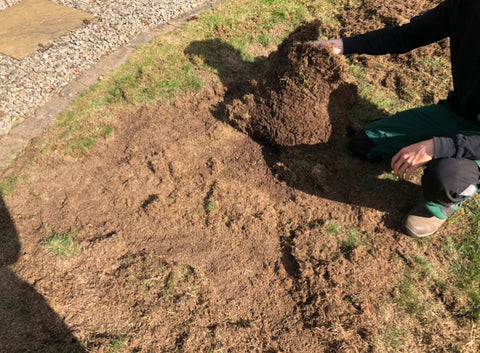What Is A Leatherjacket/Chafer Grub?
Posted on February 22 2023,
Leatherjacket and chafer grubs are classified as garden pests that lay eggs in your lawn and can cause significant damage and hinder your lawn renovation, as they grow underneath the surface layers causing damage to your entire lawn.

What are Leatherjackets (crane flies)?
Commonly known as the larvae of the crane fly, these pests can completely destroy a lawn if left unchecked.
While a small population is becoming more and more common in domestic soils and isn't always essential to treat, a larger population definitely needs to be controlled.
What are chafer grubs?
The larvae of chafer beetles are very similar to leatherjackets in that they feed on the grass roots, can be spotted using the same methods as below.
What is the difference between chafer grubs and leatherjackets?
Unlike leatherjackets chafer grubs usually have two pairs of legs on the front body making it immediately recognisable. It can be an attractive grub with light brown head, a favourite food for crows.
What is the life cycle of leather jacket larvae?
Depending on their life cycle they can look drastically different - looking at the picture below you'll see the difference and what you need to look out for on your lawn at different times of the year. However, the signs of an infestation (as outlined in the next section) are much easier tell-tale signs that you are suffering from a chafer or leather jacket infestation.
-
Eggs are planted
-
Larvae hatch
-
Pupae stage
-
Adult crane fly stage
How do I know if I have leatherjackets or chafer grubs?
There are a few ways you can tell you may be suffering from an infestation:
-
You will begin to notice a lot of dead grass, particularly in patches which will make the lawn surface easy to pull up
-
You may notice a lot of daddy long legs on your lawn (also known as a crane fly)
-
Your lawn has become the meeting point for the local bird population and the birds pecking your lawn consistently
-
You may notice physical chafer grubs (crane fly larvae) in your soil surface.

When should I treat my lawn for leather jackets or chafer grubs?
This completely depends on the time of year and how this relates to the pests life cycle. You can treat them much easier in autumn than spring as you want to kill them when they are at the larval stage rather than their final form.
It is important you treat an infestation before applying any grass seed as they will continue to cause lawn damage if not treated.
How do you get rid of of leatherjackets from my lawn?
There are two methods for treating an infestation:
-
Leatherjacket nematodes/Chafer grub nematodes
If you've noticed adult crane flies or any of the above signs that you may have an infestation and you These are most effective from when the eggs hatch to when they are still very small - usually the months of July-October.
Once you have applied them you will need to wait a few weeks for them to work before you consider adding any new grass to your lawn.
-
Black plastic sheeting method
You'll need to water the lawn heavily. Apply a black sheet over the lawn overnight (Screwfix sell them fairly cheap). In the morning they’ll have come to the surface and you can rake them up.
Repeat until satisfied.
There is anecdotal evidence that this method doesn't work as effectively for chafer grubs.
If you have any damage to your lawn and need to renovate it afterwards then The Lawn Pack (or The Lawn 'From Scratch' Pack if you have less than 2/3 existing coverage) is ideal to do so. It'll completely transform your lawn in just 4 weeks to thick, green, healthy and thriving!



0 comments